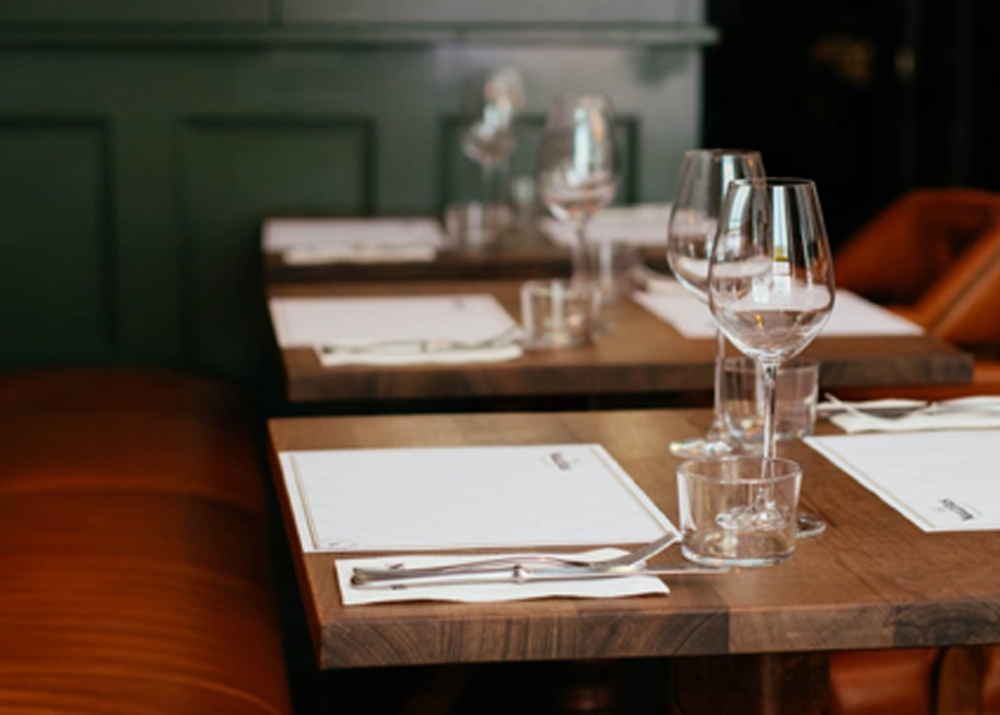


Sorry, We’re Closed: The New Sign of the Hospitality Business
How you can help your local restaurants stay afloat during COVID-19
By Apoorva Prakash
Revoked reservations and shelved ingredients became the norm as COVID-19 knocked the lights out of the hospitality industry. The inviting smiles of hosts faded away as foot traffic to restaurants quietened, and then stopped entirely. As is only right, diners are prioritizing the safety of themselves and their families, completely eliminating that once-common question, “Where are we dining out?” Meanwhile, for restaurant owners, the bills keep flying in.
The many restaurateurs voluntarily closing shop — tables against walls, chairs stacked up, menus and POS machines idle — had a domino effect. Then the government banned in-seat dining, and instant blackout fell upon us. Worried owners and management teams brainstormed ways to keep their heads above water, while being forced to lay off staff. Restaurants Canada, a non-profit liaison between the government and the Canadian food service industry, estimates that a whopping 800,000 food service jobs were lost in March alone.
The Far-Reaching Effects of Closing Restaurants
No restaurant is an island. The restaurant industry has a symbiotic relationship with the community in general, and has close connections with the nearby farms and markets they source their produce from. For that reason, the closure of restaurants doesn’t just affect the restaurants themselves, but is tied to the success or failure of the entire food industry.
The same goes for the people. The front of the house and chefs, who have spent years mastering their trade, are also consumers in their communities, and support local businesses. So a shock to the restaurant industry is also a shock to the local community in general — and helping both the people and the restaurants themselves during these challenging times will have far-reaching positive effects.
The Truth About the Restaurant Industry
To outsiders, the restaurant industry is a dynamic world of glitz and glamour. The scent of brewed coffee and freshly baked sourdough entices visitors through the doors of cafés. In higher-end establishments, team members graciously welcome patrons in for the experience of a lifetime. Crisp white linen, polished silverware, stellar service, an impeccable wine list and mouth-watering intermezzos all play their part in the show. In return, the restaurants are expecting diners to generously open their wallets and many do so without blinking!
However, backstage it’s no secret that for restaurants of any calibre, the margins are slim and the costs are steep. This includes things like rent and lease payments, food and beverage costs, payroll, sales and marketing, utilities and miscellaneous expenses. For those who have temporarily closed shop, variable expenses such as food costs and utilities do diminish to a large degree, but some remain. Fixed costs, on the other hand, aren’t going anywhere — and without enough incoming cash flow, there is no way for restaurants to cover them. With in-house dining, markups make it possible to break even, but profit margins aren’t the same for take-out and delivery. A spiraling drain, as chefs estimate recording only 20 to 30 percent of previous revenues.
While global headlines remain saturated with the word “pandemic,” corner grocery stores and big retail chains are thriving while downtown dining rooms suffer. And as restaurants and small businesses continue to battle their way to the finish line of these strange times, there are many ways you can lend a helping hand and support local businesses while waiting for restaurants to reopen.
Order Takeout and Delivery
It’s true, there has never been a more appropriate time to sling on an apron and work on your culinary confidence. Some people are rejoicing over home-cooked meals and settling into this new way of living amongst the company of loved ones. Eventually, though, this confinement to four walls, and the endless cycle of chores and rinsing dishes, gets the better of us. To give yourself a break and help out your local restaurants, consider setting aside a couple of days a week for eating out in the comfort of your home, by ordering delivery. But be aware of the commissions!
While many restaurateurs have chosen to keep their curtains drawn, others have switched into takeout mode. A recent piece by the Washington Post suggested tasting the world through restaurant delivery, sparking debate. Margins on delivery are extremely thin, especially if done through a third party delivery platform, many of which charge prohibitively high fees.
Delivery platforms like Uber Eats eventually eradicated delivery fees altogether, and switched payments to restaurants from weekly to daily to help with cash flow — but outlets using their services still have to pay a commission. DoorDash, on the other hand, wiped out commissions for thirty days. As of May 11, Foodora ceased operations in Canada entirely, blaming the highly saturated market. In March, Chef David Chang tweeted that “delivery right now is fool’s gold” — that is, that while it looks like revenue on paper, it will not be enough to save the industry, which will need to rely on institutional and systemic support.
The moral of the story: Don’t think twice before ordering delivery, but choose your third-party apps wisely.
Where possible, the ideal choice is to place your delivery order with restaurants directly. This way, the revenue reaches the business without any cuts lost to delivery services. The same goes for takeout, with the only difference being that as a customer, you’ll need to make a physical appearance (either curb-side or in-store) to pick up. Either way is helpful. And for additional ways to help, promoting your favourite restaurants on social media and tipping generously has never been more momentous.
Provide Cash for Restaurateurs and Service Industry Workers
Purchasing gift cards and merchandise off companies’ websites are instant ways to support their bottom lines. Electronic gift cards can be purchased for use at a future date — a clean, virtual, and guaranteed virus-free way to provide support until restaurants reopen. And, by sending gift cards to friends and family, you can effectively send them care packages filled with food. Reduced cash flow is making it nearly impossible for restaurants to cover their fixed costs, and purchases of gift cards and merchandise can be a big help.
Plenty of organizations have stepped up and are helping provide meals and financial assistance to service industry workers who have lost their jobs due to COVID-19. If you have cash to spare, consider making a donation to funds like the Canadian Restaurant Workers Crisis Relief Fund or the Vancouver Food + Beverage Community Relief Fund.
Bring Gourmet Meals to Your Home Kitchen
Want to cook a restaurant-quality meal at home? Restaurant owners have found the solution. Restaurants in Vancouver such as Nightingale, Forage, and Coast have set up meal kits with all the ingredients you need to make it happen. Just assemble and/or heat up and enjoy! Many kitchens are also offering four-course meal takeaway options, an attempt to carry the restaurant vibe to your table.
Some outlets are experimenting with remodeling into a grocery store. Since good establishments have direct links with wholesalers, farms and manufacturers who are also experiencing a substantial dip in income, this is an approach that benefits everyone. Consider using your local restaurant as a grocery store, if they’re offering this service — it’s a great way to access farm fresh produce and other goods you might not otherwise have access to. Depending on the area you reside in, you can either access their goodies directly, or through restaurant sites that have turned to a premium bodega, but at cheaper prices.
Café Medina, a luxurious staple on Vancouver’s brunch scene, has done a great job revamping their website with delivery and pick-up options. Despite that, as owner Robbie Kane puts it, “breaking even is the new goal now — and even that is far-fetched.” Their well-organized online grocery portal offers a plethora of choices, from coffee rations, produce and dairy to sauces, spreads and liquor. Frozen options, like their well-known petite liege style waffles, can be enjoyed now or stored for a rainy day.
Support Frontline COVID-19 Warriors
Despite being down on their luck, many restaurants have turned around and used their facilities, their staff and their food to support their local communities and frontline workers. In Vancouver, Nightingale (part of the Hawksworth Restaurants Group) has set up programs like “Feed the Frontlines,” where your contributions are used to feed doctors and nurses who are risking their lives to fight the pandemic, and “Sunday Suppers for Industry Friends,” which provides at-cost meals to industry folks who have lost their income during these tumultuous times.
The Future of the Restaurant Industry
Ultimately, deferral of loans, serving up takeout and the other approaches suggested above are merely short-term solutions. They’ll help independent restaurateurs and local businesses live to fight another day. But they’re not going to alleviate the mountain of debt hanging over their heads, and they’re not going to ensure their survival in the long run. Rent relief and bailout from evictions will be absolutely critical to keep the restaurant industry alive.
As chefs, we are united in missing the rush and thrill of racing against the clock to feed your appetite. Sommeliers, servers and breweries miss filling your glasses and playing a key role in your grand celebrations. We have all tirelessly fought to survive in this low profit-margin industry, and these days, those margins are even slimmer. Despite our enthusiasm, in the disastrous initial weeks, the numbers are looking grim. According to a survey conducted by Restaurants Canada, if a reasonable cash flow is not forthcoming within the next three months, one out of every two restaurants will close, and most restaurants with more than one location will have to close one outlet. Three quarters of restaurants that responded to the survey are very concerned about rising debt levels.
There are so many questions about the future of the restaurant industry. Will fine dining be just as trendy? What will the layout of dining rooms be like in future? What will commission figures look like, and will the average cheque be in the same ballpark? For the time being, food enthusiasts, industry leaders and government bodies will have to join hands (figuratively, of course) and come together to save the industry from dire straits. As always, we are eager to spread out our welcome mats, entertain you in our dining-rooms, and cook our hearts out once restaurants reopen. In the meantime, we are thankful for any support you are able to offer us — it truly means the world.
Apoorva Prakash is a freelance writer with a strong affinity for food, travel and culture. Her culinary stints include L’espalier, Boston; GAA, Bangkok; and Masque, Mumbai. She is currently at Hawksworth Restaurant, Vancouver.
Photo credits: Tim Mossholder, Jacky Tan, Valeria Boltneva








